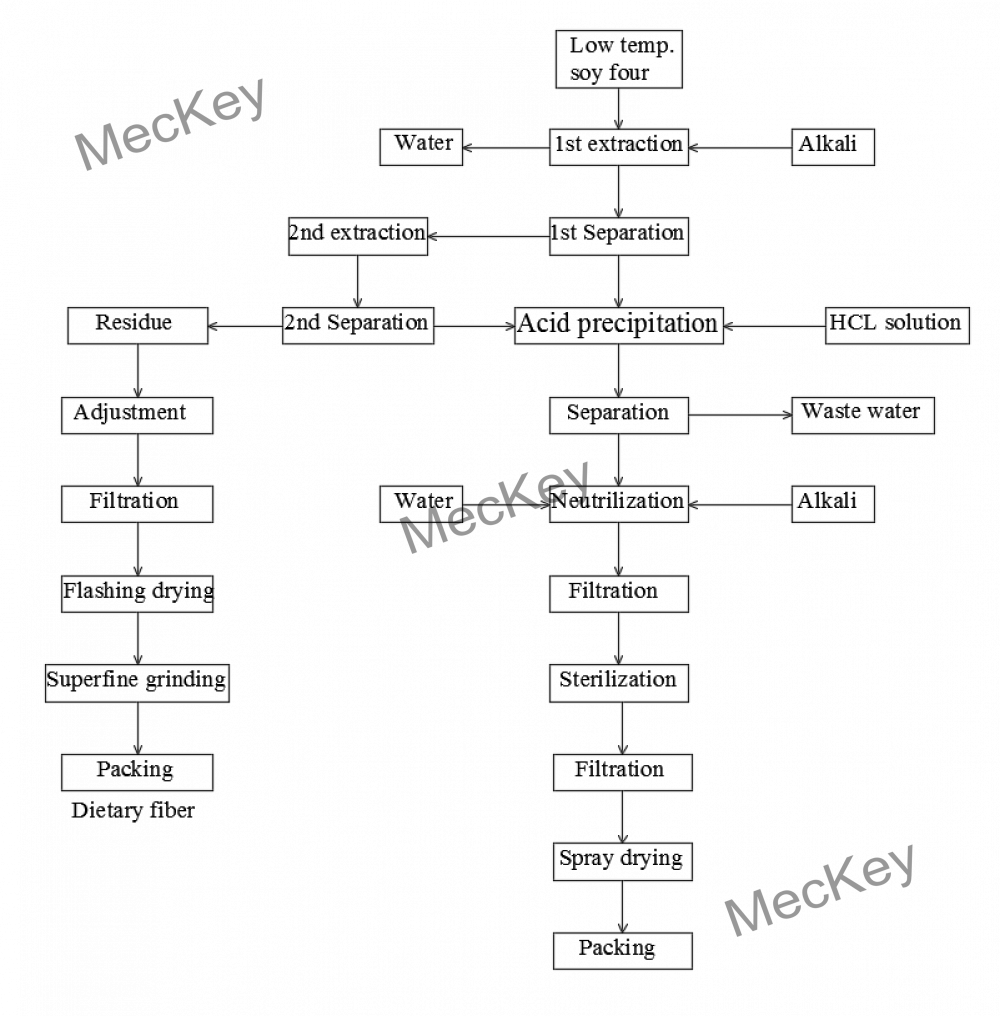Isolated Soy Protein
Last update 2022-07-01
Process block diagram

Process description
The entire production process of isolated soy protein includes feed extraction and separation, acid precipitation and separation, neutralization and sterilization flash evaporation, spray drying, and finished product packaging. The process of each section is described as follows (see Annex 1):
(1) Feeding & extraction and separation section
During production in the workshop, the process water and soybean meal are added to the extraction tank according to the ratio specified by the process parameters, the specified amount of sodium metabisulfite and liquid caustic are added, the extraction PH and temperature are adjusted for a certain period of time, and then the extraction is sent to the extraction centrifuge,The solid phase and the liquid phase are separated by high-speed centrifugation of the separator. In order to improve the product extraction rate,The solid phase after the primary centrifugal separation is added to the specified ratio of process water for secondary extraction, the material liquid after the secondary extraction is transported to the centrifuge for centrifugal separation again, and the obtained solid phase (bean dregs) is transported to the fiber workshop (or directly sold) ), the liquid phase (soy milk) from the first centrifugation and the second centrifugation is transported to the soy milk tank.
(2) Acid precipitation and separation section
Using the principle that soy protein can coagulate and settle at the isoelectric point (acidic), add a prescribed amount of hydrochloric acid to the soy milk to control the PH value within the isoelectric point range of the protein,In order to prevent the growth of microorganisms, a certain amount of sodium metabisulfite is added, and after precipitation according to the specified time, the centrifuge is used for high-speed separation to obtain curd and whey water;The whey water enters the sewage treatment through the sewage pipe and is discharged after the treatment reaches the standard. However, because the curd has a lot of clumps, it needs to be grinded and broken up with a specified proportion of water, whipped into a homogenate, and then enters the neutralization section.
(3) Neutralize section
Add the required amount of lye to the protein solution in the neutralization tank,after adjusting the PH value to the specified range, filter through a filter to remove impurities, and transport it to the sterilizer for direct steam for high-temperature instantaneous sterilization,The sterilized protein liquid enters the flash tank to cool down and concentrate, and at the same time achieve the purpose of deodorization.
(4) Drying section
The protein material liquid that has been concentrated and deodorized by flash evaporation is filtered and then sent to the spray drying tower by a high-pressure pump evenly,Dehydrate and dry with hot air in the drying tower, the bottom product enters the cyclone separator to settle and collect, and the tail gas is discharged into the air.The isolated soy protein powder collected by the cyclone separator is sieved by the vibrating sieve and then sent to the bag filter by air. The product obtained by the sedimentation is uniformly mixed in the finished product tank and then passed through the vibrating sieve and then sent to the packaging room.
(5) Packing section
The protein powder product sent to the packaging room is packaged and passed through the terminal metal detector. If it is detected that the product is contaminated by metal, it will be reviewed and processed immediately, and the product that has passed the metal detector safely is placed in the finished product warehouse for storage.